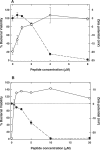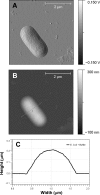Escherichia coli cell surface perturbation and disruption induced by antimicrobial peptides BP100 and pepR
- PMID: 20566635
- PMCID: PMC2934620
- DOI: 10.1074/jbc.M110.130955
Escherichia coli cell surface perturbation and disruption induced by antimicrobial peptides BP100 and pepR
Abstract
The potential of antimicrobial peptides (AMPs) as an alternative to conventional therapies is well recognized. Insights into the biological and biophysical properties of AMPs are thus key to understanding their mode of action. In this study, the mechanisms adopted by two AMPs in disrupting the gram-negative Escherichia coli bacterial envelope were explored. BP100 is a short cecropin A-melittin hybrid peptide known to inhibit the growth of phytopathogenic gram-negative bacteria. pepR, on the other hand, is a novel AMP derived from the dengue virus capsid protein. Both BP100 and pepR were found to inhibit the growth of E. coli at micromolar concentrations. Zeta potential measurements of E. coli incubated with increasing peptide concentrations allowed for the establishment of a correlation between the minimal inhibitory concentration (MIC) of each AMP and membrane surface charge neutralization. While a neutralization-mediated killing mechanism adopted by either AMP is not necessarily implied, the hypothesis that surface neutralization occurs close to MIC values was confirmed. Atomic force microscopy (AFM) was then employed to visualize the structural effect of the interaction of each AMP with the E. coli cell envelope. At their MICs, BP100 and pepR progressively destroyed the bacterial envelope, with extensive damage already occurring 2 h after peptide addition to the bacteria. A similar effect was observed for each AMP in the concentration-dependent studies. At peptide concentrations below MIC values, only minor disruptions of the bacterial surface occurred.
Figures






Similar articles
-
Peptide:lipid ratio and membrane surface charge determine the mechanism of action of the antimicrobial peptide BP100. Conformational and functional studies.Biochim Biophys Acta. 2014 Jul;1838(7):1985-99. doi: 10.1016/j.bbamem.2014.04.004. Epub 2014 Apr 15. Biochim Biophys Acta. 2014. PMID: 24743023
-
Synthesis, biophysical and functional studies of two BP100 analogues modified by a hydrophobic chain and a cyclic peptide.Biochim Biophys Acta Biomembr. 2018 Aug;1860(8):1502-1516. doi: 10.1016/j.bbamem.2018.05.003. Epub 2018 May 9. Biochim Biophys Acta Biomembr. 2018. PMID: 29750913
-
Effect of AMPs MSI-78 and BP100 on the lipid acyl chains of 2H-labeled intact Gram positive bacteria.Biochim Biophys Acta Biomembr. 2020 May 1;1862(5):183199. doi: 10.1016/j.bbamem.2020.183199. Epub 2020 Jan 25. Biochim Biophys Acta Biomembr. 2020. PMID: 31987866
-
Design and characterization of novel antimicrobial peptides, R-BP100 and RW-BP100, with activity against Gram-negative and Gram-positive bacteria.Biochim Biophys Acta. 2013 Mar;1828(3):944-55. doi: 10.1016/j.bbamem.2012.12.002. Epub 2012 Dec 13. Biochim Biophys Acta. 2013. PMID: 23246973
-
Deciphering the Mechanism of Action of the Antimicrobial Peptide BP100.Int J Mol Sci. 2024 Mar 19;25(6):3456. doi: 10.3390/ijms25063456. Int J Mol Sci. 2024. PMID: 38542427 Free PMC article. Review.
Cited by
-
Potential Application of Protamine for Antimicrobial Biomaterials in Bone Tissue Engineering.Int J Mol Sci. 2020 Jun 19;21(12):4368. doi: 10.3390/ijms21124368. Int J Mol Sci. 2020. PMID: 32575446 Free PMC article.
-
The effects of interfacial potential on antimicrobial propensity of ZnO nanoparticle.Sci Rep. 2015 Apr 15;5:9578. doi: 10.1038/srep09578. Sci Rep. 2015. PMID: 25873247 Free PMC article.
-
Ultrastructural analysis of the rugose cell envelope of a member of the Pasteurellaceae family.J Bacteriol. 2013 Apr;195(8):1680-8. doi: 10.1128/JB.02149-12. Epub 2013 Feb 1. J Bacteriol. 2013. PMID: 23378507 Free PMC article.
-
Two-Phase Bactericidal Mechanism of Silver Nanoparticles against Burkholderia pseudomallei.PLoS One. 2016 Dec 15;11(12):e0168098. doi: 10.1371/journal.pone.0168098. eCollection 2016. PLoS One. 2016. PMID: 27977746 Free PMC article.
-
Human organoid biofilm model for assessing antibiofilm activity of novel agents.NPJ Biofilms Microbiomes. 2021 Jan 25;7(1):8. doi: 10.1038/s41522-020-00182-4. NPJ Biofilms Microbiomes. 2021. PMID: 33495449 Free PMC article.
References
Publication types
MeSH terms
Substances
LinkOut - more resources
Full Text Sources
Miscellaneous

